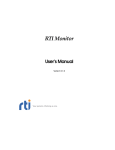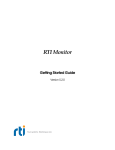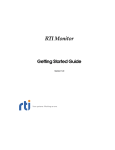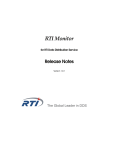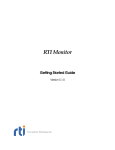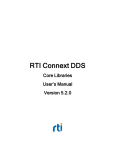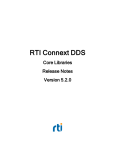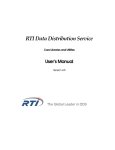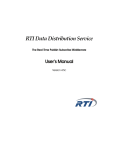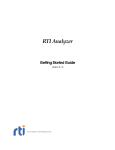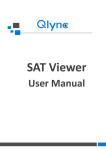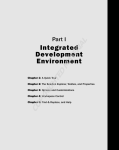Download User`s Manual - Community RTI Connext Users
Transcript
RTI Monitor User’s Manual Version 4.5 © 2010-2012 Real-Time Innovations, Inc. All rights reserved. Printed in U.S.A. First printing. March 2012. Trademarks Real-Time Innovations, RTI, and Connext are trademarks or registered trademarks of Real-Time Innovations, Inc. All other trademarks used in this document are the property of their respective owners. Copy and Use Restrictions No part of this publication may be reproduced, stored in a retrieval system, or transmitted in any form (including electronic, mechanical, photocopy, and facsimile) without the prior written permission of Real-Time Innovations, Inc. The software described in this document is furnished under and subject to the RTI software license agreement. The software may be used or copied only under the terms of the license agreement. Technical Support Real-Time Innovations, Inc. 232 E. Java Drive Sunnyvale, CA 94089 Phone: (408) 990-7444 Email: [email protected] Website: https://support.rti.com/ Contents 1 Welcome 2 Starting Monitor 2.1 Command-line Options.........................................................................................................2-1 3 Using Monitor 3.1 Tree Views ...............................................................................................................................3-2 3.2 Working with Monitor’s Panels ...........................................................................................3-4 3.3 Entity-Specific Panels ............................................................................................................3-5 3.3.1 Status Panel ................................................................................................................3-6 3.3.2 Chart Panel..................................................................................................................3-8 3.3.3 Description Panel ......................................................................................................3-9 3.3.4 Notifications Panel...................................................................................................3-11 3.3.5 Distributed Logger Panel .......................................................................................3-13 3.4 System-Wide Panels and Tables .........................................................................................3-17 3.4.1 System Overview Panel .........................................................................................3-17 3.4.2 All Notifications Table ............................................................................................3-21 3.4.3 System Types Table .................................................................................................3-22 3.4.4 Processes Table ........................................................................................................3-22 3.5 Joining and Leaving Domains ...........................................................................................3-23 3.6 Saving and Loading Data ...................................................................................................3-23 3.7 Connecting and Disconnecting the Display .....................................................................3-24 3.8 Changing Transport Settings in the Configuration File..................................................3-25 iii iv 1. Welcome Chapter 1 Welcome RTI® Monitor is a graphical tool that displays monitoring data from RTI Connext™ (formerly RTI Data Distribution Service) applications. Monitor will help you: ❏ Understand your sys- Connext Application Connext Application RTI Connext (core) RTI Connext (core) RTI Monitoring Library RTI Monitoring Library tem with an easy-to-use graphical view into your entire Connext application. ❏ Verify your design by making sure your Connext entities are communicating as expected. ❏ Tune performance by providing deep statistics on every aspect of the middleware’s operation. RTI Monitor ❏ Optimize integration with detailed information on every Connext entity in your system. ❏ Monitor real-time operation with a dashboard of tools to see traffic patterns, errors, lost samples, and more. You can run Monitor on the same host as the Connext application or on a different host. 1-1 Welcome To enable a Connext application to provide monitoring data to Monitor, the application needs to use the Monitoring Library plug-in. Connext notifies Monitoring Library every time an entity is created/deleted or a QoS is changed. Monitoring Library also periodically queries the status of all Connext entities. Monitoring Library sends all the data to Monitor once it gets the data from the Connext application. Monitoring is enabled in the application by setting values in the DomainParticipant’s PropertyQosPolicy (programmatically or through an XML QoS profile). Refer to the Monitoring Library Getting Started Guide, included with the Monitoring Library bundle, for details. Monitoring Library is available from the RTI Support Portal (accessible from https://support.rti.com/). 1-2 2. Starting Monitor Chapter 2 Starting Monitor On Linux systems: Start Monitor using the provided rtimonitor script. For example, if you installed Monitor in /opt/rti, start it by entering: > /opt/rti/RTI_Monitor_<version>/scripts/rtimonitor On Windows systems: Start Monitor by double-clicking <installation directory>\scripts\rtimonitor.bat. You can also start it from the command-line if you need to use any of the options described in Section 2.1. 2.1 Command-line Options Monitor accepts the command-line options in Table 2.1. Table 2.1 Command-line Options Option -aggregationPeriodSeconds <seconds> Description Monitor periodically goes through all the monitored entities in the system (this information is saved in its own database) to calculate aggregated statistics and states. This value controls that minimum period (specified in seconds). Default: 5 seconds -help Displays all command-line options. 2-1 Starting Monitor Table 2.1 Command-line Options Option -historyDepth <value> Description Monitor saves some statistics’ history, so it can be displayed in the charts. This option controls how much historical data (number of samples) is saved per monitoring topic. Default: 12 samples -ignoreTypeConflicts Instructs Monitor to ignore any type conflicts. In Monitor, type conflicts are based on type-code equality rather than type compatibility. This command-line option can be useful if you have types that have different type-codes but are compatible. Default: Not specified (do not ignore type conflicts) Specifies which domains Monitor will join when it starts up. <domain_id_list> is a list of domain IDs, each separated by a comma. -initialDomainIds <domain_id_list> To specify multiple domain IDs on a Windows system, enclose the comma-separated IDs in quotation marks. For example: -initialDomainIds “31, 32”. Default: If not specified, you will be prompted to enter a domain ID when Monitor starts. -matchRefreshPeriodSeconds <seconds> Specifies the period at which to refresh the system overview panel's matches. Default: 5 seconds -notificationHistoryDepth <value> -pruneDeadObjectsPeriodSeconds <seconds> Specifies the number of notifications to keep per entity. Default: 12 notifications Sets the period at which Monitor should clean up user-interface objects (such as the Host, and Process nodes in the tree views) that are no longer current (have no more children nodes in the tree view). This value should be increased when dealing with very large systems where the time to complete discovery is longer than the default value of 3 seconds. Default: 3 seconds 2-2 Command-line Options Table 2.1 Command-line Options Option Instructs Monitor to use multiple threads (according to the number of cores on the host) to retrieve data from its Connext DataReaders (which contain monitoring data). This is typically only needed for very large systems. Default: Not specified (use a single read thread to retrieve data at a period of 1 second) Sets the verbosity for Monitor and Connext. -verbosity <value> 0: silent (both Connext and Monitor) 1: errors (both Connext and Monitor) 2: warnings (Monitor only) 3: warnings (both Connext and Monitor) 4: information (Monitor only) 5: tracing (Monitor only) 6: tracing (both Connext and Monitor) Default: 1 2-3 2. Starting Monitor -spawnReadThreads Description Starting Monitor 2-4 Chapter 3 Using Monitor Monitor consists primarily of tree views and panels. There is also a toolbar for easy access to the most commonly used commands. This chapter provides more details on Monitor’s components. 3. Using Monitor Tree Views Charts and Panels Number of Monitored Entities Time Range for Chart Panels 3-1 Using Monitor Figure 3.1 Monitor’s Toolbar A Sy s te m O ll N ver vi ot ew if Sy ica t st em ion s Ty Pr pe s oc es se s Ba ck w ar Fo d rw ar Jo d in D Le om av ai e n D D is c o m ai o Sa nne n ve ct Lo Da ad ta C Da le ar ta A ll N T il e ot ific St at at io us ns C ha rt D es cr ip N o t tio ific n a D ist tio rib ns ut ed Lo gg er Entity-specific Panels System-wide Panels 3.1 Tree Views There are two tree views on the left: ❏ The Physical View displays all entities, arranged by their physical containment. ❏ The DDS Logical View displays all the entities, arranged by domains and topics. When you select an entity in one of the panels, it becomes selected in the tree. Similarly, when you select an entity in a tree, any entity-specific panels are updated to display information for the newly selected entity. One exception to this is if you use the pin button in the upper-left corner of the panel. When a panel is pinned to an entity, it will periodically receive updated data for the pinned entity—even when another entity is selected in the tree. 3-2 Tree Views Figure 3.2 Physical and DDS Logical Views Physical View DDS Logical View 3. Using Monitor Note: “Topics” and “DomainParticipants” appear strictly to help organize the tree; they are not entities. If you select either of these while viewing an unpinned entity-specific panel, Monitor behaves as if you selected the domain or DomainParticipant above it in the tree. 3-3 Using Monitor 3.2 Working with Monitor’s Panels Monitor has several panels that display monitoring data in graphical and tabular form. Some panels show data for a specific selected entity, while others show system-wide information: ❏ Entity-Specific Panels • Status Panel (Section 3.3.1) • Chart Panel (Section 3.3.2) • Description Panel (Section 3.3.3) • Notifications Panel (Section 3.3.4) • Distributed Logger Panel (Section 3.3.5) ❏ System-wide Panels and Tables • System Overview Panel (Section 3.4.1) • All Notifications Table (Section 3.4.2) • System Types Table (Section 3.4.3) • Processes Table (Section 3.4.4) You can create these panels by: ❏ Using the Window, Create Panel option from the menu ❏ Right-clicking an entity and selecting from the popup menu (entity-specific panels only) ❏ Clicking a button on the toolbar (see Figure 3.1) You may have multiple panels of each type open at the same time. Panels can be arranged by various options in the Window menu. There is also a Tile button in the toolbar. Tile button 3-4 Entity-Specific Panels 3.3 Entity-Specific Panels The contents for entity-specific panels change to show whatever entity is currently selected in the tree view. You can, however, ‘pin’ a panel to an entity to prevent it from switching contents; to do so, use the pin button in the upper-left corner of the panel. When a panel is pinned to an entity (you will see the pin button changed to ), it will periodically receive updated data for the same pinned entity—even when another entity is selected in the tree. The entity for the entity-specific panel (pinned or unpinned) is indicated by the entity hierarchy list at the top of the panel. The backward and forward the entity-selection history. buttons in the toolbar can be used navigate through 3. Using Monitor 3-5 Using Monitor 3.3.1 Status Panel The Status panel displays real-time statistics for the selected entity. Figure 3.3 Status Panel Parent list for the selected entity Delta value shows the change for the update period Sequence numbers are displayed for: —Reliable DataWriters when “Filter by match” is set to All Matches —DataReaders when “Filter by match” is set to a specific endpoint (not All Matches) It displays statuses of the selected entity, or an aggregation of all the statuses of all the entities that belong to that selected item. For example, if you select a DataWriter, the statuses are just for that entity. If you select a Publisher, the statuses are an aggregation of those for all DataWriters that belong to that Publisher. Aggregation calculation period can be controlled by the command-line parameter -aggregationPeriodSeconds (see Table 2.1 for details). Basic and Advanced options are provided. Basic data only includes Sample Statistics and Heartbeat Statistics (for reliable readers or writers only). The Advanced option 3-6 Entity-Specific Panels shows all the available statuses for the entity (some of the data is only available for reliable readers or writers). Warnings and Error Statuses Warnings and errors are checked for some of the statuses; warnings are highlighted in yellow, errors are in red. See Section 3.3.4 for details on which statuses are checked for warnings or errors. To clear the warnings and errors status of ALL entities in the system, select the button from the toolbar or Actions, Clear All Notifications from the menu. The Common Information section shows you general information about the entity— the GUID for the entity for this panel, when the data was last updated, and the current update period. Filter by match only appears for DataWriters and DataReaders. If anything other than All matches is selected, the data shown in the Status panel will only include data that belongs to the matching kind that you have selected—a subset of the data for the entire entity. Filter options for DataWriters ❏ All matches ❏ A selected locator ❏ A selected matching endpoint (DataReader) ❏ All matches ❏ A selected matching endpoint (DataWriter) Above: Example filter options for a DataWriter. The locators are for the transports. The matching endpoint is a DataReader. Below: Example filter options for a DataReader. The matching endpoint is a DataWriter. 3-7 3. Using Monitor Filter options for DataReaders: Using Monitor 3.3.2 Chart Panel The Chart panel graphs the selected statistics (on the Y axis) over time (the X axis) for the selected entity. You can control the time range with the slider at the bottom of the main window, and other chart properties by right-clicking within the chart area. Filter by match only appears for DataWriters and DataReaders— Section 3.3.1 describes the choices. The Chart Data options depend on the type of the selected entity. The number of samples that can be displayed in the chart is controlled by the -historyDepth command-line option (see Table 2.1 for details). To plot multiple chart data for the same entity at the same time, create multiple Chart Panels. Figure 3.4 Chart Panel Slider controls the time range for all charts 3-8 Entity-Specific Panels 3.3.3 Description Panel The Description panel’s contents depend on what is selected in the tree view. There are three tabs which may appear: ❏ QoS (appears for all Connext entities)—Shows the QoS settings for the selected entity. Figure 3.5 Description Panel’s QoS Tab DataReaders)—Shows the propagated QoS in the builtin topic for the selected entity. Figure 3.6 Description Panel’s Builtin Topic Data Tab 3-9 3. Using Monitor ❏ Builtin Topic Data (appears for DomainParticipants, DataWriters, and Using Monitor ❏ Data Type (appears for DataWriters and DataReaders)—Shows the type code, serialized size, and IDL representation of the associated data type: Figure 3.7 Description Panel’s Data Type Tab The Description panel is not applicable when a system, host, or process is selected, since they are not Connext entities. 3-10 Entity-Specific Panels 3.3.4 Notifications Panel The Notifications panel displays the selected entity’s current status (normal, warning or error) and a historical list of all related alarm statuses. Warnings are highlighted in yellow, errors are in red. Figure 3.8 Notifications Panel To clear the warnings and error status of ALL entities in the system, select the ton from the toolbar or Actions, Clear All Notifications from the menu. but- Historical statuses will never be cleared. The number of saved historical statuses is controlled by the -notificationHistoryDepth command-line option (see Table 2.1 for details). Table 3.1 lists the conditions that are considered warnings or errors. Type conflicts might be ignored if the -ignoreTypeConflicts command-line option is used (see Table 2.1 for details). 3-11 3. Using Monitor Clearing Notifications Using Monitor Table 3.1 Warning and Error Conditions Entity DataReader Conditions Warning or Error Type conflicts (equality comparison) Error Incompatible QoS Error Samples rejected Error Deadlines missed Warning Liveliness lost Warning Samples lost Warning Using push_on_write = false with best-effort reliabilError ity or an asynchronous publisher DataWriter 3.3.4.1 Type conflicts (equality comparison) Error Incompatible QoS Error Inactivated DataReaders Error Liveliness lost Warning Deadlines missed Warning DomainParticipant On same host as another DomainParticipant that Error does not agree on using shared memory Topic Inconsistent topic status Error Additional Information from RTI Distributed Logger RTI Distributed Logger is a library that enables applications to publish log messages to Connext. If you are interested in purchasing Distributed Logger, please contact your RTI Sales representative. If a Connext application uses Distributed Logger, the log messages it sends to Monitor are used as an integral part of the entity state kept for the associated Process. You can see this in Figure 3.9, where log messages have changed the Process' state to Error because there are error-level log messages. This is a simple but powerful way to monitor the health of a distributed system with minimal integration work. If the application already tracks its state, it can write updates to the state for Warning and Error to the log. Those will be picked up by Monitor and reflected in the display. See also: Distributed Logger Panel (Section 3.3.5). Note: Monitor cannot downgrade entity state from Error to Warning to Normal. You can make this change explicitly with the Clear All Notifications button on the toolbar. 3-12 Entity-Specific Panels Figure 3.9 Distributed Logger Panel Monitor’s Distributed Logger panel allows you to see messages from Distributed Logger, a separate library that can be integrated with Connext applications. You can also use this panel to control Distributed Logger. Distributed Logger is integrated into Monitor's entity state (normal, warning, and error) tracking feature. Therefore error and warning messages logged to an application's logging system and sent to Monitor through Distributed Logger will change a process’ status to Error and Warning, respectively. The Distributed Logger panel is associated with Process entities. Therefore it only displays information when a Process is selected from the Physical View and that Process is running an instance of Distributed Logger. 3-13 3. Using Monitor 3.3.5 Notifications Panel: Integrating Log Message Level with Entity State Using Monitor Figure 3.10 Distributed Logger Panel Selected Process As seen in Figure 3.10,the Distributed Logger panel has three tabs: ❏ Messages Tab (Section 3.3.5.1) ❏ State and Controls Tab (Section 3.3.5.2) ❏ File Logger Tab (Section 3.3.5.3) When a Process containing an instance of Distributed Logger is selected, the cached log messages populate the table in the Messages tab, and the State and Controls and File Logger tabs are updated to reflect the state of the Distributed Logger instance. 3-14 Entity-Specific Panels 3.3.5.1 Messages Tab The Messages Tab, shown in Figure 3.10 and Figure 3.11, displays a table containing the log messages from the currently selected Process. The messages can include those logged using the application’s logging library, RTI Logger, as well as the standard out and standard error of the application, depending on how the application configured Distributed Logger. By default, the messages are presented sorted based on the order in which they were written. By clicking on the column headers, you can re-sort the table to meet your needs. The panel also has a “Find” button to do simple string searches, a control to limit the number of rows which are displayed, and a view filter which shows filters messages that are less severe than the selected level. At the bottom of the panel is a detailed display for the selected messages from the table. This is primarily useful when the log message contains multiple lines (only a single line is displayed in the table). Figure 3.11 Distributed Logger Panel’s “Messages” Tab 3. Using Monitor Messages from all Distributed Logger instances for the selected Process Details for the selected message 3-15 Using Monitor 3.3.5.2 State and Controls Tab The State and Controls tab, shown in Figure 3.12, provides the ability to control the verbosity of the Distributed Logger instance directly from Monitor. It also provides control over the RTI Logger verbosity and shows the most recent (if any) response to commands it has processed. Figure 3.12 Distributed Logger Panel’s “State and Controls” Tab } } } 3.3.5.3 Distributed Logger Verbosity Control Connext Verbosity Control Most recent response to a command File Logger Tab The File Logger tab, shown in Figure 3.13, provides a way to save log messages for a single Process to a file. This is especially useful when issues are noticed for a Process and you want to capture the output to share with others for analysis. Another more generalpurpose way to save log messages to a file is provided as an example with Distributed Logger and is detailed in the Distributed Logger Getting Started Guide. The File Logger tab provides inputs for the file path and the queue size. There are displays that show how many messages have been written as well as dropped (due to queue size). The current and maximum queue sizes are also displayed. Note: The File Size may not update as quickly as the Messages Written count. In fact, the File Size is usually zero until several messages have been written. This is because buffering is used to increase the throughput performance while writing to the file. 3-16 System-Wide Panels and Tables Figure 3.13 Distributed Logger Panel’s “File Logger” Tab 3.4 System-Wide Panels and Tables 3.4.1 System Overview Panel The System Overview panel displays a map of the entities in the system. You can change the criteria for how items in the map are highlighted by selecting the Notifications, Matches, or Measurement option. A Key is provided to indicate the meaning of the different highlights in the map. If the Notifications option is selected, the map will show all the entities in the system and their colors will show if they are in normal, warning or error mode. If the Matches option is selected, the map will show all the entities that are currently matched and all the entities that are currently unmatched due to potential errors. For an ‘ideal match,’ opposing endpoints (DataWriters and DataReaders) must have the same domain ID, same topic name, and belong to compatible partitions (if any are specified). This list of ideal matches is compared to the list of actual matches received from Monitoring Library to determine which entities are marked as matches or mismatches in 3-17 3. Using Monitor System-wide panels and tables show a summary of the states of the whole system. Using Monitor Figure 3.14 System Overview Panel (Notifications Option) A visual map of the system. The outer-most box represents the host. T= DR = DW = Sub = Pub = DP = P:# = Topic DataReader DataWriter Subscriber Publisher DomainParticipant process ID the map. There are various reasons for a mismatch, such as incompatible QoS or data types, misconfigured discovery peers, or use of the Connext ignore_*() APIs, among other reasons. The matches are shown at the peer-level only. That is, if you select a Publisher, you will not see matches for the DataWriters that belong to it. Table 3.2 provides more information on what matches are shown for selected entities. Table 3.2 Peer-Level Objects If you select this type of object ... 3-18 You will see matching information for ... Host Hosts DomainParticipant DomainParticipants Publisher Subscribers System-Wide Panels and Tables Table 3.2 Peer-Level Objects If you select this type of object ... You will see matching information for ... Subscriber Publishers DataWriter DataReaders DataReader DataWriters Topic Topics If an entity is highlighted as ‘Partially Matched,’ some (not all) of its child entities are not matched (such as a Publisher that has one matched DataWriter and one or more unmatched DataWriters.) The -matchRefreshPeriodSeconds command-line option controls how often the matching information is refreshed (see Table 2.1 for details). Figure 3.15 System Overview Panel (Matches Option) 3. Using Monitor 3-19 Using Monitor If the Measurement option is selected, the Measurement and Scale drop-down menus are enabled. Measurement allows you to select which data value to display in the map. Scale allows you to control the scaling factor of the data value. Figure 3.16 System Overview Panel (Measurement Option) Move the mouse over an entity in the map will show you the details of that entity for the selected highlight mode. The Display Name Controls simply control how the items in the map are labeled (or whether they are hidden). Each entity types can be hidden from the map, labeled tersely (with just an abbreviation for the entity type, such as T for a Topic), or include more information, such as T {Topic Name}. 3-20 System-Wide Panels and Tables 3.4.2 All Notifications Table The All Notifications Table shows you all the current errors and warnings for the entire system (not just the currently selected entity). Figure 3.17 All Notifications Table This panel has filters to include or exclude warnings/errors. Errors are shown in red. Warnings are shown in yellow. If a row is selected in the table, the Select in Views button selects the entity in tree views on the left. The Find button is useful for searching through a large table. (This is a simple string search, so you must use the exact same form as displayed in the table.) Clicking on a column heading will sort the table by the values in that column. Clicking it again will sort in the opposite order. Click here to see these options You can change the order of the columns by simply dragging them to a new place in the table. 3-21 3. Using Monitor The button just above the vertical scrollbar allows you to choose which columns appear in the table. It also has options to pack (resizes) columns and enable a horizontal scrollbar. (Note: to enable the ‘Pack Selected Column’ option, select a cell in the top row.) Using Monitor Clearing Notifications To clear the notifications, select the Notifications from the menu. 3.4.3 button from the toolbar or Actions, Clear All System Types Table The System Types table displays all the known data types in the selected domain. The Domain drop-down menu includes a list of all the joined domain IDs for you to select. Like the All Notifications Table (Section 3.4.2), this table also has a button (above the vertical scrollbar) to control the columns that appear in the table. You can also sort the table based on any of the columns by clicking the column heading. The Find button is useful for searching through a large table. (This is a simple string search, so you must use the exact same form as displayed in the table.) 3.4.4 Processes Table The Processes table displays memory and CPU information for all the processes in the system. These values are valid only if the host is a Linux or Windows system. For multi-core machines, CPU usage can be greater than 1. 3-22 Joining and Leaving Domains Like the All Notifications Table (Section 3.4.2), this table also has a button (above the vertical scrollbar) to control the columns that appear in the table. You can also sort the table based on any of the columns by clicking the column heading. For example, you can quickly sort by Total CPU to see which process is using the most. When the process row is selected in the table, you can use the Select in Physical View button to see where this process is within the physical tree. The Find button is useful for searching through a large table. (This is a simple string search, so you must use the exact same form as displayed in the table.) 3.5 Joining and Leaving Domains You must specify the domain(s) in which you want Monitor to monitor. When Monitor starts, you will be prompted to enter a domain ID (unless you start it with the -initialDomainIds command-line option). 3. Using Monitor You can also join and leave domains by using the and buttons on the toolbar or the commands in the Domain menu: To see the currently joined domains, select Domain, Show Current Domains... from the menu. 3.6 Saving and Loading Data Monitor can work with live data or data that’s been saved to a file. To save monitoring data, use the button on the toolbar or select File, Save Data... from the menu. The file will be saved in a Serialized Java Objects format (.ser). 3-23 Using Monitor To load a data file, use the button on the toolbar or select File, Load Data... from the menu. When Monitor is working with saved data, you will see (Historical data mode) in the title bar, followed by the filename. For example: Monitor will save notifications, descriptions, and statistics (for DomainParticipants, DataReaders, and DataWriters), up to the history depth or notification history depth for every object being monitored. Notes: ❏ While viewing saved data, you will not see built-in topic data or the IDL representation of the data type in the Description panel. This information is not saved in the data file. ❏ You cannot save data while using a loaded data file. ❏ After viewing saved data, to return to live data you must reconnect to the domain(s) that you want to monitor by joining the domain (see Section 3.3.5). 3.7 Connecting and Disconnecting the Display To stop Monitor from updating the display (while still receiving data), select the ton on the toolbar or Actions, Disconnect Display from the menu. To resume display updates, select the Display from the menu. but- button on the toolbar or Actions, Connect Note: Data samples may be lost at the Connext level while Monitor’s display is disconnected because the History QoS is configured to only keep the last few samples. 3-24 Changing Transport Settings in the Configuration File 3.8 Changing Transport Settings in the Configuration File The QoS used by Monitor are in <installation directory>/config/ rtimonitor_qos_profiles.xml. You can edit this file to adjust the QoS to fit your system's needs. The typical use case is to adjust the transport settings so that they align with the other applications in the system, as these are critical for communication. However changing any other settings in this file may result in unpredictable behavior and is not supported. Generally, the configuration file is editable on the system. There are certain circumstances where it cannot be updated, such as on Windows 7 when Monitor is installed in the "Program Files" directory. If this is the case, open your text editor with 'administrative' permissions before opening the QoS file. 3. Using Monitor 3-25 Using Monitor 3-26






































